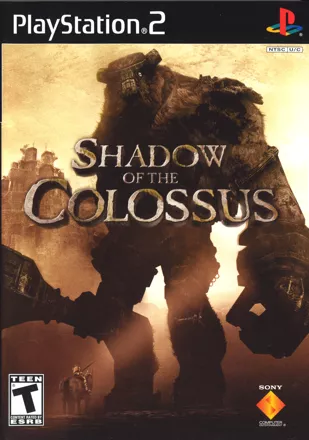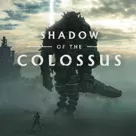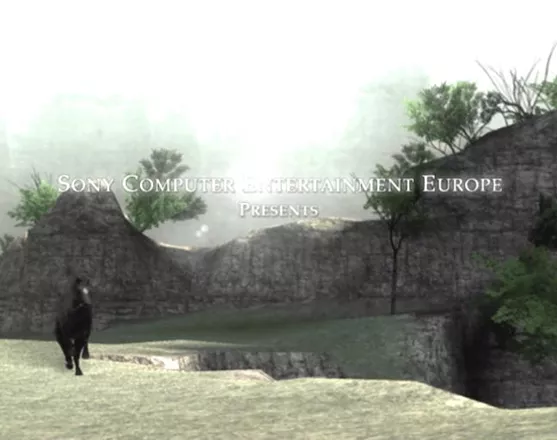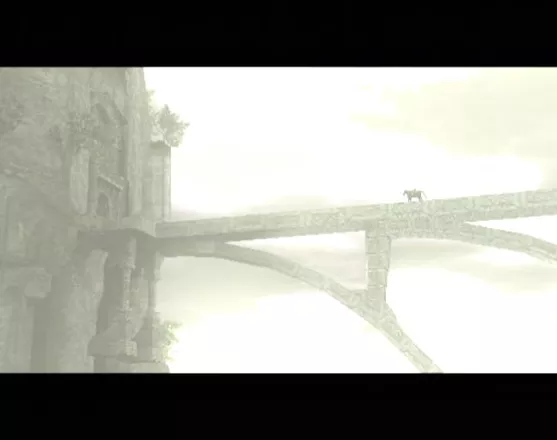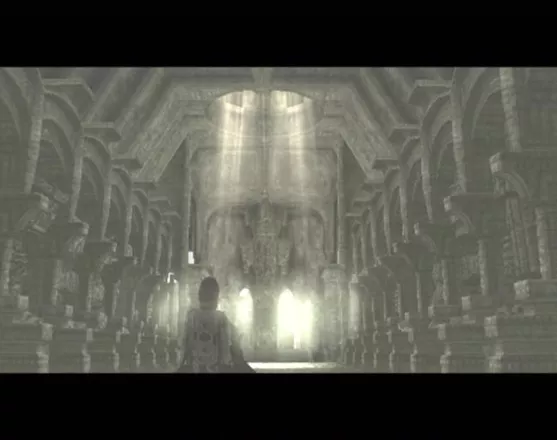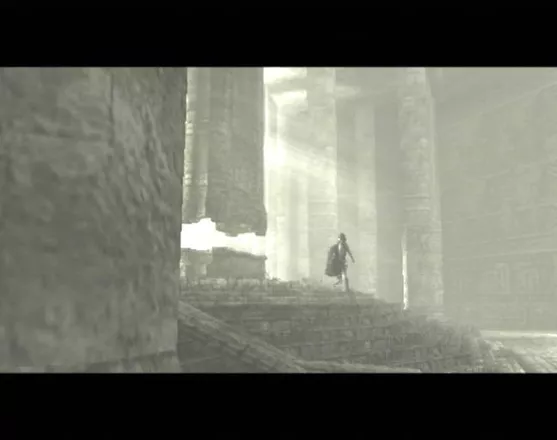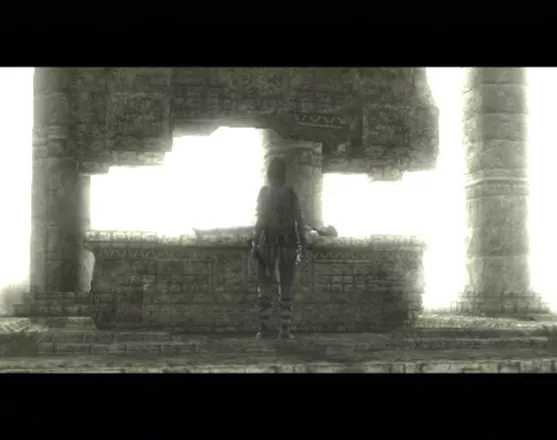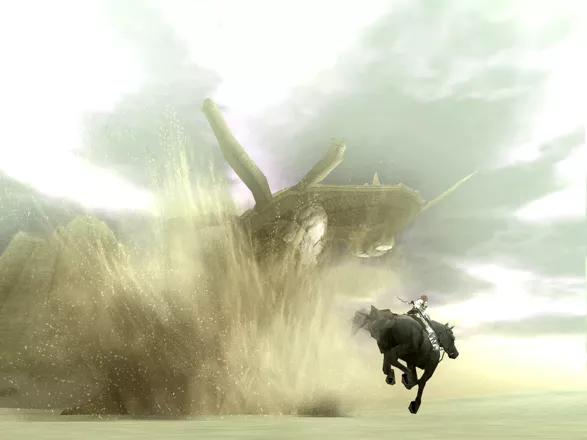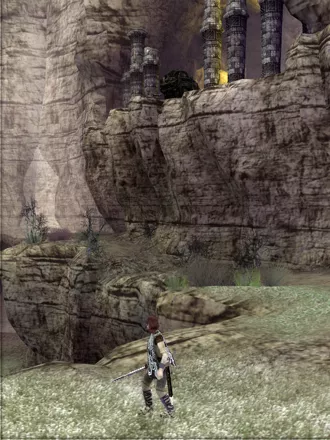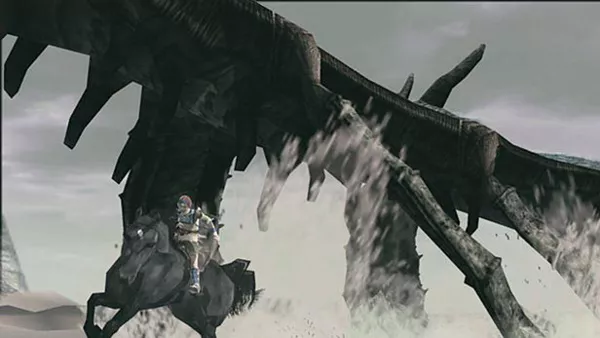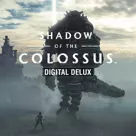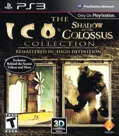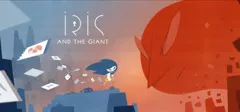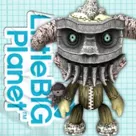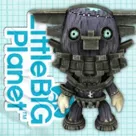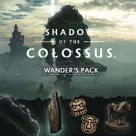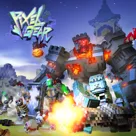Shadow of the Colossus
Description official descriptions
In an ancient time long past, a young man travels to the ends of the Earth, a place that is said to be forbidden to enter. He carries a young woman, who died from a terrible curse. He seeks the Dormin, a strange and God-like being that resides there. The Dormin is surprised that the man carries an ancient and magical sword, and speaks to the man. The man pleas for his help in bringing back the woman's cursed soul, however the being says it is the law of mortals that a dead soul cannot be brought back. He does say though, that if the man is willing to accept some heavy consequences, that there might be a way to revive her. But it will not be easy.
The hero must embark on a quest to slay the sixteen colossi, giant creatures that tower hundreds of feet above the Earth. Using his ancient sword and his horse Agro, he must travel across the immense landscape seeking the colossi to save his love. Taking the form of various animals or bipedal human-like creatures, these colossi are tough and fierce. Their skin is tougher than leather, and the armor they wear is literally rock. However, by using his ancient sword, the man can penetrate the weak spot on them and destroy the towering beings and free his love's soul.
Shadow of the Colossus is set in the same universe as ICO, and is a prequel to it. The entire game is dedicated to locating and fighting the sixteen colossi, which must be faced and defeated in a particular order. Finding the giant creatures is not always easy: the hero must mount his horse and ride through the world's vast landscapes, using his glowing sword as an indicator of the colossus' proximity. There are no enemies or hazards in the game world outside of the colossi battles. After a colossus has been found, a large-scale battle begins. Most of the colossi are huge, and much of the challenge in the battles lies in climbing on top of these creatures and staying there, while they are trying to shake the player character off. In a certain way the colossi function as hostile, moving platform stages.
The general goal in every battle is to reach the colossus' weakpoint and repeatedly stab it with the sword until he dies. Since the colossi vary greatly in shape, size, speed, intelligence, and attitude towards the hero, the player will have to adapt to different fighting styles and employ different tactics against them. Most of the battles involve extended platform action sequences, as the hero is trying to climb on the colossus and find its weak spot. Grabbing the creature's fur, timing the jumps, and getting in a good position to use the sword are often essential. Other tactics include fighting on horseback, using ranged attacks with the bow, luring the colossus into specific locations to use the environment against it, taking advantage of the terrain, etc. Environments in which battles take place are also varied, including mountains, deserts, lakes, ancient ruins, and others.
Spellings
- ワンダと巨像 - Japanese spelling
- 汪达与巨像 - Chinese spelling (simplified)
- 완다와 거상 - Korean spelling (Hangul)
Groups +
Screenshots
Promos
Videos
Add Trailer or Gameplay Video +1 point
See any errors or missing info for this game?
You can submit a correction, contribute trivia, add to a game group, add a related site or alternate title.
Credits (PlayStation 2 version)
262 People (225 developers, 37 thanks) · View all
| Game Design | |
| Planning | |
| Game Script | |
| Camera Setting | |
| Sound Setting | |
| Character Design | |
| Character Animation | |
| Effects Design | |
| Field Design | |
| [ full credits ] | |
Reviews
Critics
Average score: 92% (based on 51 ratings)
Players
Average score: 4.2 out of 5 (based on 150 ratings with 10 reviews)
The Good
Oooh. If you thought that size doesn't matter, then think again. I think that this is the very first game that really shows that concept. The game is about you battling these over-sized colossal monsters. Underline colossal. It's not big, it's not large, it dang HUGE!
The monsters you face are literally 5 story (more or less) tall buildings! And they're not biological, their mostly rock-covered. The first time you see one, it's like...uh...it's my funeral. It is quite fun the first couple times around, trying to find out "how the hell you defeat a creature that dang big" which is the next question after "how the hell do you get ON that dang creature?"
Each of these over-sized dang monsters are different. Can't explain all but wait to the part when you see a flying 5 story building. Now that'll keep you dumb-folded for several minutes!
You can also ride a horse in this game...and a big horse it is! Three times 3-5 times larger than our hero who looks like a dwarf compared to this horse. The good ol' horse here takes you around the land which is incredibly huge. Again, not big, not large, but huge!
The Bad
Is it me or am I the only one that doesn't like this game? (see other reviews).
My one-line summary is "What a waste..." and after the 8th monster I defeated, I got bored. This is why:
- The land is incredibly huge.
Beautiful and huge, but the thing is, that's all it is. Big, a lot of landscape, but nothing else. No people, no monsters in the middle, the game is just travelling between Point X to Point Y on your horse. The distance between X and Y (referring to the huge landscape) is just travelling distance that cannot be interacted with one way or another. Point: Eye candy. It's useless, all that graphical capability and it has no use whatsoever, if you take away the huge landscape, it doesn't effect the gameplay. I have a problem with eye-candy graphics when it doesn't do much more than just being eye-candy.Final Fantasy for example has a lot of eye candy, but in that game its function is to "back-up" a plot or story. Here, it doesn't back-up squat. - Acting.
Horrible. Well, not horrible, I would go as far to say there isn't any. One-two liner sentences by that strange voice in the temple. The monsters don't talk much either... - Story.
There isn't one. Which quite amazes me why anyone would actually put a good review about this game. After many adventures and RPG games with incredible storylines, one would think a game with this much potential would come up with a better plot. Oh, you want to know the story: Girlfriend dead. Bring to temple. Voice in temple says, defeat 18 big guys, maybe we bring her back to life. Hey, I just summed it up in 3 lines! No sub-quests, no interaction with different plots. I've seen linear storylines, but a puzzle game has more plot than this game! Someone was too lazy to hire a good writer. It's just about defeating monsters...period. No style...dang peasants. - Repetitive tactics.
As there wasn't so much as any mystery to the game, even after defeating several monsters, I got bored. After the 8th, I got really bored. It's probably just another new monster, get on it, hang on and try to stick that sword in its weak spot. If there were a story to set the mood, maybe I would've finished the game. This game is like a girl that doesn't talk much, not much interaction with a person gets you bored real quick.
The Bottom Line
Maybe I missed something, as many websites all had a lot of good reviews and ratings on this game...I seem to be the only one that finds this game somewhat boring.
Maybe I have high standards for games or the game industry has lowered its gaming standards over these years.
But regardless of how good a game appears to "look". It's useless without a story. A beautiful girl or handsome guy without any brains? Yep. That's this game.
PlayStation 2 · by Indra was here (20756) · 2006
The Good
Once the introduction to "Shadow of the Colossus" is through playing and option to start a new game appears the audience knows that they are about to embark on an interactive journey like nothing else they have ever played. Like all good story telling the introduction tells the audience what they are in for. The camera set-up is following a bird soaring through a canyon, and beyond it is a great big beautiful world where you will live for the near future. There is orchestral music playing but the audience only hears a few solitary instruments - there are moments of quiet and stillness that give the audience time to think and remark. There is a man on a horse traversing difficult terrain and they work together to jump to higher ground; there is comfort and friendship between horse and rider. What the audience is left with is a feeling, not exposition - and that's what this title is about: feeling.
Drama aside there is a plethora of other "good stuff" to talk about. First the camera. There has been some criticism made about the camera system - I think they are misdiagnosed and reviewers fail to acknowledge how successful the designers were to create a camera that even worked for something this ambitious. And the camera does more than get the job done. - it feels purposeful and always reacting to the dynamics of the title.
The camera follows the controls very closely. But the camera has to deal with three different types of control: character, character on horse, and character interacting with the colossi. Normal player controls feel allot like "Ico"; that is a good thing. Character on horse controls are simply awesome. You the player feel like you are actually riding a horse, an animal that has a mind an instincts of its own, instead of directly controlling every movement of the horse. There are many points in the game where you the player can put down the controller and the A.I. of the horse will navigate the world successfully. Finally there is character interacting with the colossi control. They are very intuitive and fit the purpose perfectly. Clambering up and down giants that are always moving, scrambling to hang on for dear life when they attempt to throw you off their bodies, and making your attacks on them are executed wonderfully, and more importantly, simply.
The visuals of the game are, of course, beautiful. The distance that the player can see is limited only by the horizon. Distant mountains are hazy and close rivers are a torrent. The character models are dazzling and the colossi are truly a thing to behold. In conjunction with the visuals are the movements in the game. The models are not just beautiful to look at they are beautiful to see in motion. When your character is fleeing on the ground from a lumbering colossi the look is familiar and surreal. When the character mounts his horse, either to ride to a colossus or from a colossus, is either some of the best key-framing or best motion capture ever done for a videogame.
And finally, the music is what binds this adventure together. It takes the experience beyond a meager television screen and showers the audience with magic. It catapults the events on the screen into your mind and gives them a voice of their own.
The Bad
The game is so much fun that the audience might feel guilty identifying some of "Shadow of the Colossus's" weaker points. There are some instances of a drop in frame rate. But to the developer's credit the pace of the game does not slow with the frame rate, so the action continues at the same rate. This is evidence that the developers knew they were encountering limitations in the PS2 technology but sought to overcome it the best way they could.
The Bottom Line
All people would be better off playing this game, (or at least seeing it be played). There were moments in this game I will never forget. But these moments were unlike anything other in a videogame. I felt a sense of awe and joy, and I relished every second and every minute of it. When the character is toppled from a colossus, scrambles to his feet, and with a press of the X button yells desperately for his horse "Agro", you the player are no longer in a room with four walls, your back on your horse accelerating between the legs a moving mountain, standing up in the saddle, and preparing to jump back onto the colossus that you must bring down.
PlayStation 2 · by D P (129) · 2006
Big is not scary; small is scary
The Good
Video games are a lot of fun. Hot damn, one thing the modern age has brought us is a never-ending supply of entertainment in the form of internet chatting, web surfing for information, compiling information for an online database as well as just playing video games. In fact, video games are at times so fun that they are difficult to put down and compel the player to not stop. This is called addiction, and there are some gamers who believe a good video game should have this addictive quality; at one time the video game magazine GamePro had it as one of its rating requirements. The assessment is a fair one in this context; fun is what people want and expect in a game, so it makes sense for them to have a game that doesn’t stop being fun. If a game is addictive, then it serves its own purpose very well as a leisure activity or “time-killer”, if you will. That’s what a game is: an activity that you partake in and, win or lose, you enjoy yourself during the time you are doing it.
Videogames are also a burgeoning expressive art form. What once was quick, simple fun has evolved to telling complex stories of ambiguous morality that may resonate deeply with the player’s emotions. From its crude beginnings, videogames have become a billion-dollar industry as a pop-culture sensation and a technological marvel. However, this balance of being both a game and as art has never been resolved. Take for example, this issue: “Do video games make people think? Do videogames challenge people such that they are different people at the end of the experience?”
This “thinking” is actively thinking, thinking to come to a conclusion that hasn’t been thought of before and not just thinking mechanically. Sure, there’s a lot of thinking going on in games. This takes a myriad of forms in the plethora of different videogame genres: action games require fast, reflexive thinking; puzzle games require abstract problem-solving; RPG’s may require moralistic decision-making. The differences are vast as are the heated discussions to which is better, but they are all the same in the as they require the player to operate within the set parameters that the game lays out for you. You are following the game; the player is making decisions only based on what the game asks of you. Once again, this is pretty much just using your brain and not thinking on your own and coming to your own conclusions.
The game play aside, what success video games have achieved somewhat in terms of thinking are games that “make you think”. Games have matured in the recent past by tackling social issues and telling compelling stories that people affect people long after the game is over. One quick example is Dragon Quest VIII: Journey of the Cursed King, where despite fighting cute monsters in random battles the main story has themes of child abandonment, sibling rivalry, a death in the family as well as racism (or monsterism, though this is minor). Modern video games are not slow to tackle new and unproven themes that once may have been too edgy for an audience.
However, a video game is still a game, no matter how well a video game tells a story or challenges the player to think outside the box. Besides anything else a game aspires to be, they must be fun to play. The entire experience of having a wonderful story told to you with amazing graphics and wonderful music is compromised by one thing: you are playing a video game with the purpose to win it. Almost every game made has a “game over” screen, and as a gamer you’ll do everything you can not to be staring at it. Whatever thinking you do while playing a video game usually has to do with the video game itself; if it is a smart and good video game then it will shape your thinking to become addicted to the game play. Addiction is not thinking; addiction is doing something without thinking.
And then you have Shadow of the Colossus, a masterpiece of a game that is so good people are usually left sputtering adjectives of praise but not able to describe why it’s so good. The likes of this game, which pits the unknown protagonist against 16 epic boss fights in order to save a dead woman, has never been seen before and likely its kind won’t be seen again. It’s a unique experience that raises the bar as to what a video game can achieve in terms of artistic expression. Lots have been written about the various colossi and the “purity” of boiling a game down to just the boss battles in which a boss is the anthropomorphism of a video game level. Shadow of the Colossus is an unique blend of having action/puzzle game play in an adventure game; it tells a touching story that is very out of place for a video game, and succeeds because of it. It is an extremely immersive game that is emotive without being crass and manipulative. It is the most well-made video game created because you will understand and appreciate exactly what the developers are trying to say and do.
You’ve read it all before in any of the hundreds of reviews that universally praise this game. While the praise is well-deserved, Shadow of the Colossus succeeds as a work of art because it does something that just about no video game ever made does: it lets you think.
That’s right: it lets you think. It doesn’t crowd your brain with superfluous decision making or needless details. You have a set objective, and to achieve that you must best these colossi, whom you can figure out how to beat by just looking at them. This takes place in a set world that is extremely detailed and immersive with no loading times. This is a simple and pure game, and because the set parameters are so few and unexplained—you must kill these colossi in this beautiful world without knowing why—as you play the game it lets you think.
That’s “let you think”, not “make you think”. Shadow of the Colossus isn’t so self-important to take itself so seriously. If it has anything important to say, then it challenges you to figure it out. This game is similar to the brilliance of Bioshock that permits the player to be as immersive in the story if they choose to do so, but in Shadow of the Colossus the details must be filled in by the player themselves because the story is told so sparsely and mysteriously. As in both games, a player can blaze through from beginning to end, enjoy themselves and be witness to a marvelous experience, and not know why.
This concept of “letting you think” is no better exemplified than by the game’s most important characters: the environment and the player’s horse, Agro. It is riding through this “cursed land” on your beloved horse that is the essence of the game, not the novelty of solely fighting epic boss battles where you have to climb on somebody to kill them. Take for instance: it is evident a vast percentage of the resources available for game development where allocated to making the world environment and to making the horse run and operate properly. The gigantic world is beautifully detailed and well designed and runs without any load times whatsoever. Agro is the most realistic depiction of a horse in a video game (compared to Gun, for example), and besides accurate, realistic-type controls Agro features a smooth transition from a walk to a trot to a gallop, no mean feat for an animal with four legs.
If the stars of Shadow of the Colossus are the colossi themselves, then wouldn’t a prudent development decision be to focus just on the colossi themselves? If you devoted the resources making the world environment and the horse (who is only used to as part of the colossi battles for a regretful few) to making the colossi, then we would have a game that could feature twice as many colossi, or ultra-smart colossus A.I. that could quiz you what your favorite color is before you cross a bridge. Wouldn’t more and better colossi make a better Shadow of the Colossus game?
No. If this decision was made and, for example, the game took place in a castle where you walk from room to room (like ICO), all the inspiration and magic would be gone because there isn’t a context for things to happen in. This can be seen in the game itself; after beating it once, the game features a challenge mode where you can walk up to the statue of any one colossus (all located in the same room) to play and replay the boss fights; fun, but not part of the amazing game experience.
Riding through the huge world is the real essence of the game. Just like every other part of the game, the environment is simplified and devoid of any real animals, save some tiny animals—it’s just riding. There are no random battles to encounter to level up your stats, as there are no NPC’s to encounter to take quests and buy weapons. It is a pure element, just like all the elements in this game. After receiving orders as to which colossus to whack next—the fantasy world equivalent of a GTA crime boss you take missions for—the player rides to the next destination with only your magical sword to serve as a compass. For a game that tells its story so subtly and is very stingy with any concrete details, this journey is the best part of the game because even though you are riding to the next colossus the real action takes place in your own damn brain.
That’s right, for this day and age where everyone demands better graphics the best part of Shadow of the Colossus takes place in your own imagination. As the distance grows, so does the anticipation. The mind fills with questions: What will the next colossus look like? If the last one was so tough to beat, how will I beat this one? What is the purpose of these colossi? Who is the mysterious woman I’m trying to save? But most importantly, why? Why am I trying to kill these magnificent creatures? Why do I feel regret even as I inch closer to my objective?
Shadow of the Colossus doesn’t ask you these questions; no, it lets you think for yourself. As you’re riding and thinking about these things your thoughts will drift to other subjects, but since your mind is already in a critical state of mind you are likely to do some more. That’s right, this game fools you into thinking for yourself. Genius, this is nothing short of genius. This game transcends the parameters it sets itself becomes something much more by using the best story teller you know: yourself.
Shadow of the Colossus is a “pure” game where everything is exactly as it should be. It is a perfect blend of technology, art and inspiration. Everything about this game is as it should be: the mysterious story matches every blade of grass on the lush landscape; the tense gripping battles matches the long, silent, contemplative ride through the wilderness. This is a game that will never, ever age. 100 hundred years from now people will still appreciate this game because it couldn’t be any better, not now nor then.
The Bad
No customizable songs available on non-existent horse radio. Can’t stick a sword up a colossus’ ass. Was expecting a final boss so big that a spaceship is required to build and fly to the moon from which you can time a jump to grab onto the colossus’ toe hair.
The Bottom Line
Man, I was a bit disappointed by the difficulty of this game. I breezed through a couple of them and said out loud to the TV, “Wha? But that’s so easy!” I did need to look up a faq for the two smallest “lion” colossi, shamefully, and the last guy I just spoiled it for myself and read it before I started because I was getting “colossi-itis” and just wanted the satisfaction of ending this great game.
I went and read through a faq that tried to explain EVERYTHING about the story, and I just have to say: man, you nerds, stop trying to figure magic out. The game is great because it’s mysterious. As in the cult film “Donnie Darko” (2001), it’s cool and interesting because you have no pin-wheelin’ idea what’s going on; later on in the Director’s Cut release where everything was explained, the movie just wasn’t cool nor interesting anymore. Man, just because you think you know something doesn’t make it better or your enjoyment of it better.
The tagline to this review comes from David Lynch; he replied thusly when asked why he often has very tiny people in his movies (for example, the end of “Mulholland Dr.” (2001)). Dave’s got a point, you know; it’s tough being a giant colossus.
PlayStation 2 · by lasttoblame (414) · 2008
Discussion
| Subject | By | Date |
|---|---|---|
| Tips for riding Agro | Halleck (389) | Jan 26, 2011 |
| This is amazing | Unicorn Lynx (181780) | Jul 31, 2007 |
Trivia
1001 Video Games
The PS2 version of Shadow of the Colossus appears in the book 1001 Video Games You Must Play Before You Die by General Editor Tony Mott.
Character
Throughout the game, the main character's appearance continually gets worse from the physical and mental strain of fighting the colossi and from the strain of the dark spirits possessing him. His hair and clothes will gradually get dirtier, and his clothes will eventually tear in numerous places. Also, his face will scar and get paler as the game continues.
Demake
In September 2008 the game was "demade" for the TIGSource Bootleg Demakes competition as Hold me closer, Giant Dancer.
Development
Shadow of the Colossus is known for pushing the PS2 hardware to its limits. For example, SotC features fake HDR (High Dynamic Range) rendering, even though the PS2 hardware doesn't really support HDR.
Another example for this is the the "fur shader" - the colossi are very hairy and are the fur is rendered quite convincingly. The fur also features some simulated anisotropic lighting, giving the fur realistic highlights. Again, the common way to achieve this is not possible on the PS2, but the game developers managed to approximate this.
The game features many other technological achievements. Some are visible such as self-shadowing, and some are behind the scenes, such as the complex memory management system that allows for the huge game world without loading time or memory fragmentation.
Further details can be found in The Making of "Shadow of the Colossus" (5 MB pdf), which includes explanations from the game's developers, and in an analysis by Jonathan Cooper
Extras
The PAL release comes in a cardboard packaging containing four unique postcards with art work depicting moments from the game. It also includes camera interviews with artistic partners and creative directors Fumito Ueda and Kenjj Kaido to get a look behind the scenes, an image gallery with concept sketches and in-game stills, and the original game trailer to ICO.
References
Various philosophical elements are present in the game. For instance, Dormin is reminiscent of the biblical character Nimrod. Nimrod is a biblical king credited for the creation of the Tower of Babel, whose purpose was to build a stairway into the heavens. Before its completion, the builders tongues are mixed up into different languages (which, according to the Bible, justifies the many languages of the Earth). As well, the Tower of Babel is said to be one of the tallest structures on the Earth, and could be seen from all parts of the Earth.
The shrine of worship is completely symbolic of the Tower of Babel. Dormin is meant to represent Nimrod, the builder of the shrine, and if one notices closely, Dormin is an exact anagram of Nimrod. As well, through a secret method the character is able to climb the tower and reach a paradise, symbolic of a Heaven or other after-life paradise (notice that in the story, Mono and Wander are only able to climb to the top of the tower once they are free of Dormin, who represents Sin and evil). The tower is obviously the hugest structure on the map, and can be seen from all parts of the map (if the view is not obstructed) As well, before Dormin can ascend to total power (as if ascending into Heaven), he is split up into 16 parts, thus completing the image of the builders being divided by their changed languages.
References to the game
- The basic premise of this game (enormous monsters with light-up self-destruct buttons) is riffed on in a Penny Arcade webcomic strip dated October 21st, 2005.
- Shadow of the Colossus is referenced in the movie Reign over Me (2007) where actor Adam Sandler is addicted to it.
Savegame import
If the player has a saved game from ICO on the memory card in slot 1, Aggro's diamond shaped mark on his head will be replaced with the logo for ICO; a horn/tooth-like shape.
Awards
- 4Players
- 2006 – Best Game of the Year
- 2006 – Best PlayStation 2 Game of the Year
- 2006 – Best Action-Adventure of the Year
- 2006 – Most Impressive Boss of the Year (for Colossus 16)
- 2006 – Best Original Soundtrack of the Year
- Electronic Gaming Monthly
- February 2006 - #192 out of 200 on the "Greatest Games of Their Time" list
- GameSpy
- 2005 – #5 PS2 Game of the Year
Information also contributed by Big John WV, Christian Moleman, hribek, Indra was here, Mickey Gabel, Pseudo_Intellectual, Robstein and Sciere
Analytics
Upgrade to MobyPro to view research rankings!
Related Sites +
-
Cursedlands.com
A resource site for ICO and Shadow of the Colossus -
Making of "Shadow of the Colossus" (5 MB pdf)
Explanations from the game's developers how SOTC was made. English translation. -
Shadow of the Colossus
Official game website -
Wikipedia: Shadow of the Colossus
Information about Shadow of the Colossus at Wikipedia -
Zarf's Mini-Review
A mini-review of Shadow of the Colossus by Interactive Fiction developer Andrew Plotkin (November, 2005).
Identifiers +
Contribute
Are you familiar with this game? Help document and preserve this entry in video game history! If your contribution is approved, you will earn points and be credited as a contributor.
Contributors to this Entry
Game added by Terrence Bosky.
PlayStation 3 added by Kabushi.
Additional contributors: Unicorn Lynx, Sciere, Matt Neuteboom, Namaenashi, Zeppin, DreinIX, Arejarn, hribek, Patrick Bregger, Rik Hideto, FatherJack.
Game added November 7, 2005. Last modified February 16, 2024.
